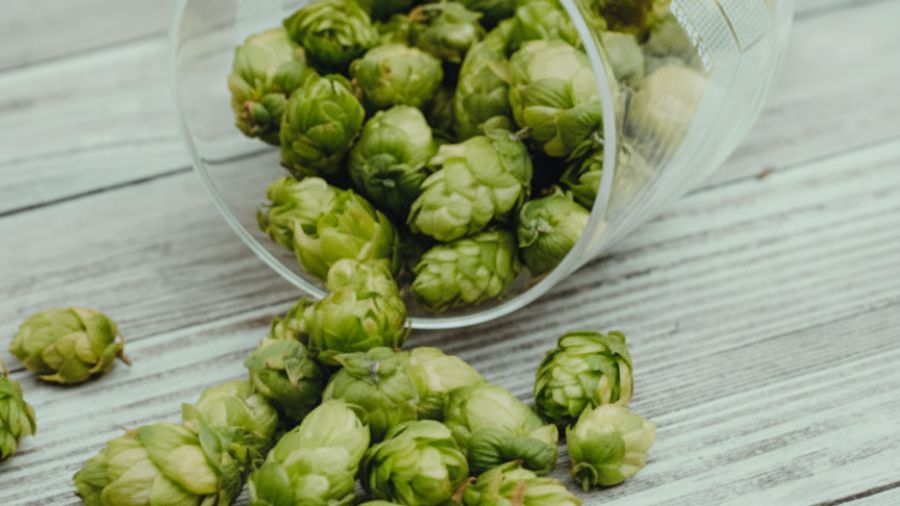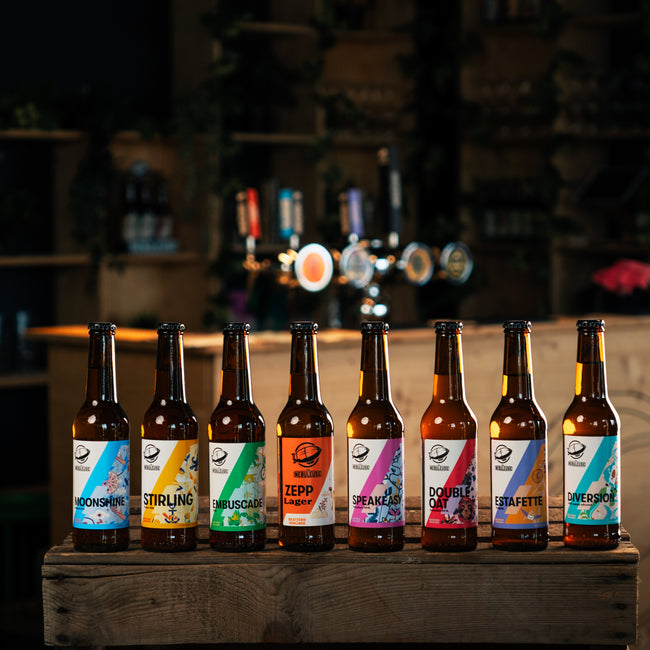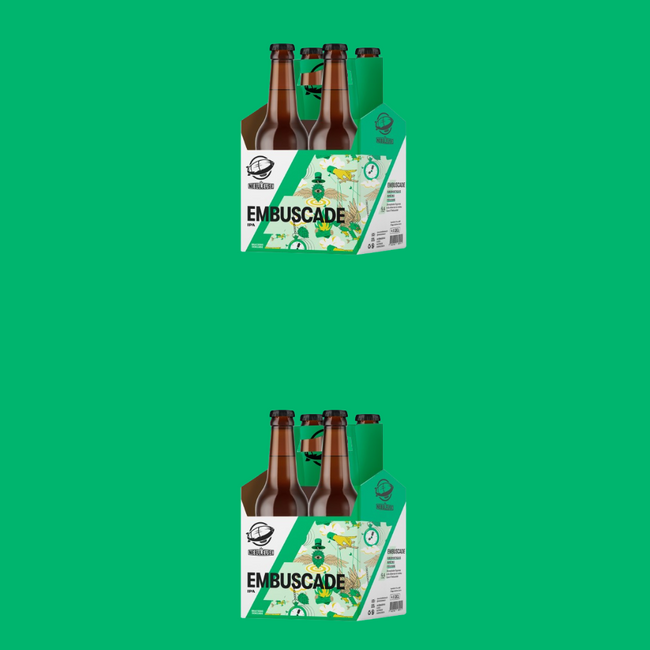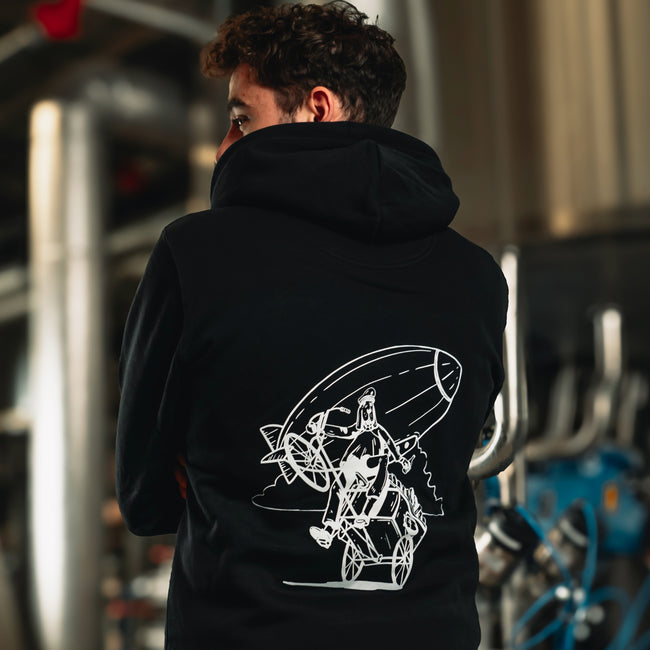The four ingredients that shape your craft beer

Four elements, a thousand possibilities
Four. That's the number of fundamental elements in the universe according to the ancient Greeks. It's also, by a coincidence that isn't really a coincidence, the exact number of ingredients needed to create that liquid miracle we call beer. Water, malt, hops, yeast. That's the basic equation that has captivated humankind for millennia. It is this adherence to fundamental and pure ingredients that raises pertinent questions about the nutritional differences between craft beer and industrial beer .
However, reducing beer to this simple sum is like claiming a Monet painting is just paint on a canvas. Each ingredient conceals a universe of possibilities. Every minute variation radically transforms the final result.
La Nébuleuse considers its brewery a laboratory where these four elements have been dancing together since 2014. Not an austere lab in a white coat, no. Rather a modern alchemist's workshop where science meets creativity, where molecules become poetry.
Understanding these ingredients is like holding the keys to the brewing kingdom. It's about going from being a simple drinker to an enlightened explorer. It's the difference between listening to music and hearing each instrument in the orchestra.
So get your taste buds ready, we're diving into the molecular secrets that transform four basic ingredients into hundreds of different flavors. From water that's never just water, to hops that do much more than add bitterness, to malt, the architect of colors, and yeast, that microscopic magician.
Water - The invisible canvas that reveals flavors
The hidden chemistry in every sip
Water. 95% of your beer. And yet, how many times have you really thought about it? This seemingly ordinary molecule - two hydrogens, one oxygen, thanks to middle school chemistry - actually hides a complexity worthy of an episode of Breaking Bad.
Because pure water, the H2O of textbooks, doesn't exist in nature. Our water teems with dissolved minerals: calcium, magnesium, sulfates, chlorides... Each plays its part in the final gustatory symphony.
Take sulfates, for example. These clever little things accentuate the bitterness of hops, giving them a sharp edge. Chlorides, on the other hand, soften the edges, adding a malty roundness. It's a bit like adjusting the bass and treble on your favorite amplifier.
The pH? This logarithmic scale, which everyone seems to have forgotten since high school, becomes crucial. Too acidic, and your enzymes will struggle during brewing. Too alkaline, and the extraction of astringent tannins will go haywire. The perfect balance hinges on just 0.2 points.
Mythical waters with legendary styles
The history of beer is also the history of water. Burton-on-Trent, this English town with its sulfate-rich waters, gave birth to the historic IPAs. Beers so heavily hopped that they survived the voyage to India. Coincidence? We don't believe in coincidences.
Pilsen and its soft water, like a caress. Almost distilled. The ideal playground for delicate lagers where the slightest misstep is glaringly obvious.
Dublin and its bicarbonate-rich waters. Perfect for balancing the acidity of roasted malts. Guinness wasn't born there by chance.
Munich, Dortmund, Vienna... Each historic brewing city owes its renown to its unique water profile. Before modern chemistry, brewers made with what they had. And what they had defined what they drank.
La Nébuleuse's approach: sculpting water like an artist
Today, we are no longer prisoners of our geography. Technology allows us to transform our local water into any historical profile. Or better yet: to create our own.
For our Zepp , this craft lager that defies style clichés, we meticulously adjust the mineral profile. Just enough calcium for healthy fermentation. A sulfate/chloride balance leaning towards smoothness. The result? A lager with character but without harshness.
Water is our blank canvas. The one on which all the other ingredients will express themselves. Too concentrated, it masks the nuances. Too pure, it lacks structure. It's a balancing act that we master brew after brew.
To delve deeper into this aquatic world, discover our detailed article: Water in brewing: the secret ingredient of exceptional beer. You'll never look at your glass the same way again.
Malt - The architect of flavors and colors
The metamorphosis of grain: when barley becomes magical
Malt is the story of a Kafkaesque transformation. Except that instead of waking up gloomy, our barley grain metamorphoses into an enzyme factory. Glamorous? Not really. Essential? Absolutely.
It all starts with a bath. The barley grains are immersed in water and begin to germinate. Inside, it's like a microscopic version of Germinal. Enzymes activate, ready to convert starch into fermentable sugars. This is the diastatic power, the superpower that maltsters control with the precision of a Swiss watchmaker.
Then comes the drying. Stop! We're stopping germination. Now we're playing with fire. Literally.
50°C? You get a Pilsner malt , blond like wheat, sweet like a lullaby.
80°C? Munich malt enters the scene , with its notes of fresh bread and hazelnut.
120°C? The caramel malts arrive , bringing toffee and dried fruit.
Above 200°C? Welcome to the territory of roasted malts , where coffee and chocolate reign supreme.
A rainbow of possibilities in every brew
We juggle a palette of malts like a painter with their colors. Every nuance counts. Every percentage changes the final equation.
The base malts – Pilsner, Pale, Vienna, Munich – form the backbone. They provide the fermentable sugars, the structure, the body. This is the canvas on which we will paint.
Specialty malts? That's where the magic happens. A touch of Caramunich for sweetness. A hint of chocolate for depth. Crystal for caramel notes. Black Patent for roasted bitterness.
Our Stirling perfectly illustrates this art of blending. Its mix of Pale Ale, Carapils, and Caramünch 3 creates a balanced malt base that provides a perfect setting for the hops. Neither too light nor too heavy. Just right so that every sip tells a story.
Beyond barley: the adventure of alternative grains
Barley doesn't have a monopoly on malt. We're exploring other grain-growing regions with the enthusiasm of a 15th-century explorer. Less scurvy, more flavor.
Wheat? Our ally for creamy textures and that persistent foam that's the hallmark of wheat beers. Rye brings its spicy, almost peppery character. Oats? They're the epitome of smoothness, the creaminess of grains.
Each grain transforms the beer. It changes its texture, its head retention, its flavor profile. It's an endless playground for us curious brewers. This exploration naturally includes the challenge of brewing without traditional grains, which has allowed us to develop gluten-free craft beers that no longer accept any compromise on taste.
To explore this fascinating malty world in more depth, delve into our article: Malt in Craft Beer: A Story of Flavors. You'll become an expert on these golden grains that give body and soul to our creations.
Hops - The virtuoso of aromas
Anatomy of a magic cone that turns everything upside down
Hops. This climbing vine that resembles cannabis - moreover, they are botanical cousins, family Cannabaceae, a disturbing coincidence - produces these green cones that transform a sweet soup into a complex nectar.
A closer look at a cone. Inside, hidden like nuggets of gold, are the lupulin glands. These tiny yellow beads concentrate everything that makes our taste buds sing. Alpha acids for bitterness. Beta acids for preservation. Essential oils for the explosion of aroma.
Alpha acids, our bitter allies, are transformed during boiling. Isomerization, they call it. A molecular dance that converts these compounds into soluble iso-alpha acids. Bitterness is measurable, quantifiable. The famous IBUs – International Bitterness Units. From 10 for a smooth wheat beer to 100+ for a Double IPA that slaps your taste buds.
But the star ingredient of craft beer hides many other secrets. Essential oils—myrcene, humulene, caryophyllene, linalool—create this aromatic symphony. Citrus, tropical fruits, pine resin, floral notes... Each variety composes its own melody.
A symphony of varieties: from the noble to the wild
European noble hops – Saaz, Tettnang, Hallertau, Spalt – emphasize finesse. Herbal, floral, and subtly spicy notes. Old-fashioned elegance. The aristocrats of hops that whisper rather than shout.
Facing them, the New World varieties arrive like rock stars. Cascade with its citrus signature. Citra with its tropical explosion. Mosaic with its bewildering fruity complexity. Simcoe with its notes of passion fruit and pine.
Our Embuscade embodies this modern approach to hopping. A bold blend that makes the taste buds dance between blood orange and pine resin. Each sip tells the story of meticulous selection, of a sought-after balance between power and harmony.
Hop-growing terroir does exist, contrary to what some claim. The same cultivar planted in the Yakima Valley, Hallertau, or in Swiss soil develops distinct profiles. Soil, climate, cultivation techniques... everything influences these precious green cones.
Creative hopping techniques: the art of capturing the essence
First wort hopping. The hops are added to the hot wort even before it boils. Gentle extraction, smooth bitterness, subtle aromatic complexity. A timeless technique brought back into fashion.
Whirlpool hopping. At 80°C, the essential oils are extracted without excessive evaporation. This is the magic zone where the aromas express themselves without bitterness becoming overpowering. We swirl, we infuse, we capture the essence.
Dry hopping. Cold hopping. The cones—or more often pellets—are dropped directly into the fermenting beer. No bitterness is added. Just fragrance, just aroma. It's like the difference between hot brewed tea and cold brew.
Biotransformation? When yeast and hops dance together. Yeast enzymes transform certain hop compounds into new aromatic molecules. Geraniol becomes citronellol. Linalool undergoes a metamorphosis. Nature does organic chemistry better than any lab.
Hops are our favorite playground. We explore, we experiment, we push the boundaries. Single hops to understand each variety. Complex blends to create unique harmonies. It's an endless art, a perpetual quest for the perfect balance.
Yeast - The Microscopic Alchemist
Transformation families: choosing your magician
Yeast. Billions of microscopic workers toiling 24/7 without a union or coffee breaks. Saccharomyces cerevisiae, for those in the know. A pompous Latin name for creatures doing a simple job: eating sugar and spitting out alcohol and CO2. Classy.
But be warned, not all yeasts are created equal. It's like comparing a Michelin-starred chef to someone who microwaves chicken nuggets. Technically, they're both cooking.
Saccharomyces cerevisiae is the rockstar of ales. It thrives at room temperature, between 15 and 25°C. It floats on the surface during fermentation – hence the term "top fermentation." It produces fruity esters and spicy phenols. It's what gives British ales their green apple notes and Belgian beers their banana and clove aromas.
Saccharomyces pastorianus? The unsung hero of lagers. It prefers cool temperatures, between 7 and 15°C. It sinks to the bottom – a bottom-fermented yeast. More discreet, cleaner. It lets the malt and hops do the talking without being overbearing.
Fermentation as an art: temperature, time and patience
Managing fermentation is like raising a Tamagotchi. Except here, we're talking about millions of hungry Tamagotchis that can turn your masterpiece into vinegar if you neglect them.
Temperature? Crucial. Every degree counts. Too hot, and your yeast goes into overdrive, producing higher alcohols that give it that solvent taste nobody likes. Too cold, and it goes dormant, leaving residual sugars and a sickeningly sweet taste.
Our Moonshine is a testament to this mastery. The Belgian yeasts used require meticulous management. We start with a cool temperature to control the esters. We gradually increase the temperature to bring out the spicy notes. It's a thermal ballet that lasts for days.
Attenuation—the percentage of sugars the yeast converts—defines the final body. A voracious yeast produces a dry, light beer. A lazy one retains roundness and mellowness. We choose our strains like a casting director chooses their actors.
New frontiers: when tradition meets innovation
The Nordic treasures that are Kveik yeasts They're turning everything we thought we knew upside down. These microscopic Vikings ferment at 40°C without flinching. They finish the job in 48 hours instead of two weeks.
Originating from Norwegian farms, passed down through generations like family heirlooms, they produce unique profiles. Intense citrus, tropical fruits, without the usual flaws of hot fermentations.
Flocculation—the yeast's ability to clump together and settle to the bottom—influences the final clarity. Some strains settle like stones, leaving a crystal-clear beer. Others remain suspended, creating the characteristic haze of hefeweizens.
We explore. We test. Each strain offers infinite possibilities. It's a microscopic universe with macroscopic repercussions.
The alchemy of four - When magic happens in our vats
Balance as a philosophy: each ingredient has its say
Now that you know our four soloists, let's talk about the orchestra. Because a great beer isn't just four ingredients coming together. It's a conversation, sometimes a lively debate, between elements that must find their harmony.
Water sets the stage. Its mineral profile determines whether the hops will sing soprano or baritone, whether the malt will play the leading role or remain in the shadows. Too many sulfates, and your IPA becomes a bitter slap in the face. Too many chlorides, and your stout turns into syrup.
Malt provides structure, sugars, and color. But it also contains aroma precursors that the yeast will transform. The melanoidins in caramelized malts give those dried fruit notes after fermentation. Roasted malts balance their bitterness with that of the hops.
Hops do more than just make things bitter. Their essential oils interact with yeast esters. Linalool in hops can transform into citronellol during fermentation. Geraniol sometimes becomes rose alcohol. It's molecular perfumery.
Yeast? It's the invisible conductor. It decides the tempo (fermentation speed), the intensity (attenuation), and the final character (esters and phenols). A Belgian yeast will transform the same ingredients into a spicy symphony, while an American yeast will opt for a more understated approach.
Innovation and tradition: pushing boundaries without losing your soul
The ingredients that make our beers unique don't stop at the four basics. We explore. Local fruits, forgotten spices, ancestral techniques revisited.
But innovation is never free. Every addition must be meaningful , must contribute something to the whole. A zest of orange in a white wine? Classic but effective. Sichuan pepper in a saison? Bold and surprising.
Experimenting with unconventional ingredients pushes us to rethink our recipes. Sometimes it works beautifully. Sometimes we learn what not to do. That's also part of the brewing adventure.
Our philosophy? To respect the fundamentals while daring to do the unexpected. Understand why the rules exist before breaking them. It's like jazz: you have to master the scales before you can improvise.
The future in our tanks: what tomorrow holds for us
The future of brewing? It's taking shape in our test tanks. New hop varieties developed for their climate resistance, but which also bring unique flavor profiles. Yeast strains isolated in extreme environments. Malts made from rediscovered ancient grains.
Technology opens doors for us. Real-time fermentation analysis. Precise oxygenation control. Dry hopping under pressure to capture 100% of the aromas. But technology is just a tool. It's passion, creativity, and a deep understanding of our ingredients that make the difference.
We continue to learn. Each batch teaches us something. Each tasting feedback pushes us to refine, adjust, and perfect. It's a never-ending journey, and that's exactly what excites us.
The adventure continues with every sip.
There you have it. Now you know the secrets of our four brewing musketeers. Water that sculpts, malt that builds, hops that perfumes, yeast that transforms. Four elements that seem simple, yet are infinite in their possibilities.
The next time you enjoy one of our creations, take a moment. Behind that perfect foam, those complex aromas, that balanced bitterness, lies a whole alchemy. Decisions made to within 0.1°C. Percentages adjusted to the gram. Timing calculated down to the minute.
But above all, there is a passion. The passion to transform these four basic ingredients into exceptional moments. To create beers that tell stories, that awaken emotions, that create memories.
Explore our range. Taste how water, malt, hops, and yeast dance differently in each creation. From the crystalline lightness of our Zepp to the spicy complexity of our Moonshine, and the hoppy explosion of Embuscade.
Because understanding the ingredients is good. Enjoying them in your glass is better. Cheers, and may the alchemy continue!
Cheers 🍻









